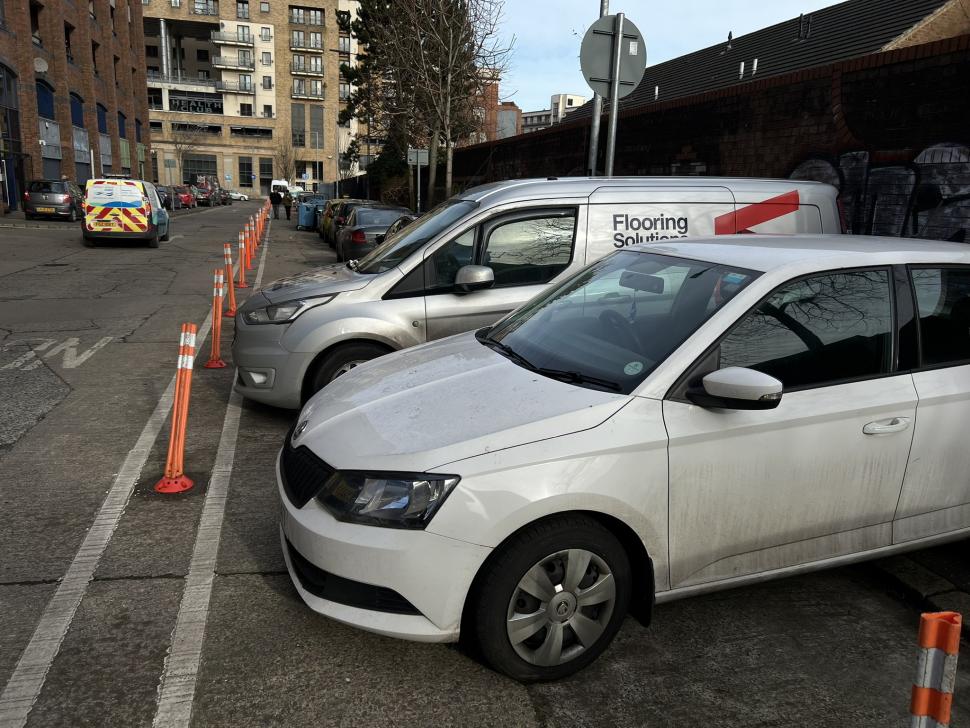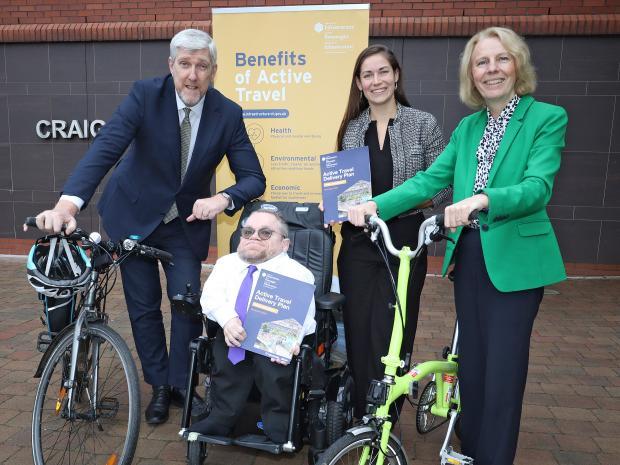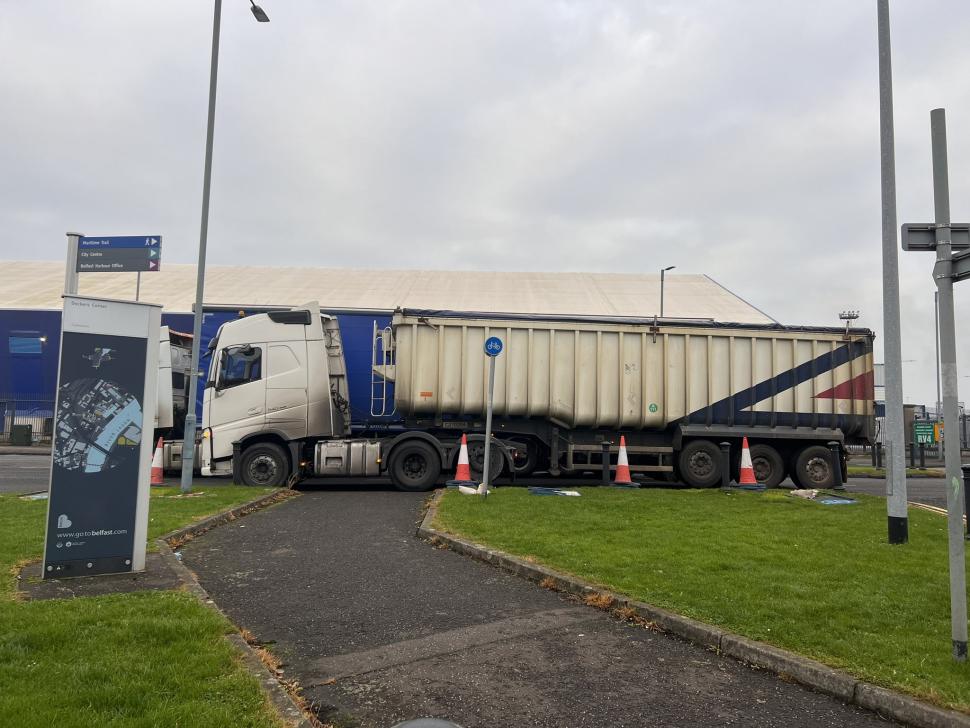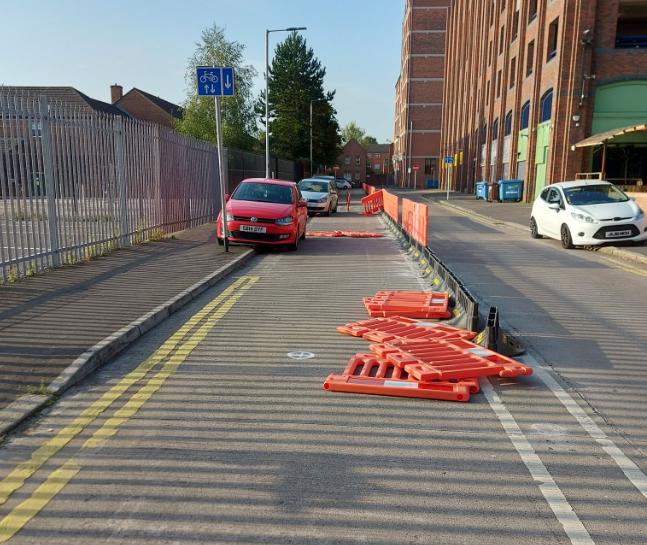- News
- Reviews
- Bikes
- Components
- Bar tape & grips
- Bottom brackets
- Brake & gear cables
- Brake & STI levers
- Brake pads & spares
- Brakes
- Cassettes & freewheels
- Chains
- Chainsets & chainrings
- Derailleurs - front
- Derailleurs - rear
- Forks
- Gear levers & shifters
- Groupsets
- Handlebars & extensions
- Headsets
- Hubs
- Inner tubes
- Pedals
- Quick releases & skewers
- Saddles
- Seatposts
- Stems
- Wheels
- Tyres
- Tubeless valves
- Accessories
- Accessories - misc
- Computer mounts
- Bags
- Bar ends
- Bike bags & cases
- Bottle cages
- Bottles
- Cameras
- Car racks
- Child seats
- Computers
- Glasses
- GPS units
- Helmets
- Lights - front
- Lights - rear
- Lights - sets
- Locks
- Mirrors
- Mudguards
- Racks
- Pumps & CO2 inflators
- Puncture kits
- Reflectives
- Smart watches
- Stands and racks
- Trailers
- Clothing
- Health, fitness and nutrition
- Tools and workshop
- Miscellaneous
- Buyers Guides
- Features
- Forum
- Recommends
- Podcast
 Cycle lane parking in Belfast (credit - Dominic Bryan, Twitter)
Cycle lane parking in Belfast (credit - Dominic Bryan, Twitter)Government “prioritising active travel over safety”, claims councillor – who says new bike lane was so wide “I thought it was a dual carriageway they were building!”
A DUP councillor has claimed that the Northern Ireland government is “prioritising active travel over safety”, after the Department for Infrastructure this week announced the launch of its new Active Travel Delivery Plan, which aims to deliver over 200km worth of “high quality” cycling and walking infrastructure during the next decade.
But while many cyclists in Northern Ireland – forced to navigate the country’s neglected, disconnected, and often shoddy cycling network – would argue that this shift to a concerted and focused active travel strategy has been a long time coming, former MLA and finance minister Mervyn Storey has questioned the budget set aside by the Department for Infrastructure for active travel, claiming that the number of cyclists on the road does not justify the money being spent.
Yesterday in Craigavon, Sinn Féin Infrastructure Minister John O’Dowd launched a public consultation on Northern Ireland’s new Active Travel Delivery Plan. According to the DfI, the plan sets out how the devolved government at Stormont will “prioritise and deliver” over 200km of cycling, walking, and wheeling schemes, located within both urban and rural settlements, over the next decade.
The plan will focus on providing linked-up active travel connections to local schools, public transport, and town centres, which the department says “will offer the greatest potential to maximise benefits for people, the environment, and society”.
However, at a Q&A session with roads officials on Tuesday evening, following the DfI’s annual address to Causeway Coast and Glens Borough Council, DUP councillor Storey drew his colleagues’ attention to a new 500m cycle path recently installed in Coleraine.
In September, work commenced on the £800,000 active travel scheme on Coleraine’s A29 Ring Road, which featured the creation of a new 500m shared footway and cycle path, as part of what O’Dowd said was “an overall vision to provide a high-quality active travel link between Coleraine and Portstewart”, along with connections to the University of Ulster.
However, speaking at the meeting, Storey – a former finance and social development minister in the Stormont executive and prominent young earth creationist – criticised the width of the new cycleway, the Coleraine Chronicle reports.
“I can’t get my head around the width of it,” he said. “I thought it was a dual carriageway they were building!”
The DUP politician then questioned the proportion of the department’s budget that is spent on active travel schemes, comparing it unfavourably against the perceived lack of cyclists on the borough’s roads.
“I think what the Department does is prioritise active travel over safety,” he said.
Responding to Storey’s criticism, a DfI official said at the meeting: “We will always prioritise safety where we can, and sometimes by doing an active travel scheme we can also improve safety.”
Of course, the concept of Northern Ireland’s devolved government prioritising active travel over anything is an alien one to many of the country’s cyclists, such is the chequered and underfunded nature of the infrastructure they are forced to deal with on a daily basis.
Campaign groups have long criticised the apparent inaction of the Department for Infrastructure when it comes to active travel, arguing that disjoined infrastructure, lack of enforcement against cycle lane car parking, and evidence that cycling is often an afterthought when it comes to big transport projects has left Northern Ireland lagging behind the rest of the UK.
In 2022, Cycling UK criticised O’Dowd for appearing to renege on a pre-election pledge to introduce an Active Travel Act, claiming the Sinn Féin minister was set to “lock us all into a fossil-fuelled dark age”.
And last year, Belfast City councillors pointed out that, despite the implementation of the Belfast Cycling Network Delivery Plan in 2021, only 2.8km of cycle lanes were installed in two years, a lack of delivery branded “incredibly frustrating” and “ridiculous”.
It’s no surprise then that this week Cycling UK, while welcoming the DfI’s announcement of its long-term active travel plans, was cautious in its appraisal of the project, warning that “the real test will be in the delivery”.
“It’s reassuring to see the Department for Infrastructure finally develop a long-term plan for active travel delivery across Northern Ireland,” Andrew McClean, Cycling UK’s Northern Ireland lead, said in a statement.
“Crucially, the proposed plan highlights the importance of short journeys connecting people to schools, public transport and town centres – but the real test will be in the delivery.
“Northern Ireland lags far behind neighbouring nations when it comes to active travel, which is why this plan needs to be backed by a real sense of urgency. Only then can we open up cycling to more people and ensure everyone can benefit from this cleaner, more accessible, and healthier transport option.”
Launching the long-awaited active travel plan in Craigavon yesterday, infrastructure minister O’Dowd said: “his plan showcases the Department’s ambitions for increasing active travel options in 42 settlements across the North, delivering a bold transformation for all of our communities.
“It will complement the existing Belfast Cycling Network Delivery Plan and the Strategic Plan for Greenways, providing our teams and local councils with a firm basis for the prioritisation and delivery of active travel over the next 10 years.
“Research has shown that over one third of our journeys are less than two miles long and two thirds are less than five miles. These shorter journeys offer an opportunity to choose a different mode of travel to the car and make small changes to our lifestyle, regardless of age or ability, by choosing to walk, wheel, or cycle.
“We want to create high quality and safe active travel infrastructure that will make a positive difference to your lives, so we need to understand how it could help you to choose active travel to make those shorter journeys, whether it be travelling to work or school, maybe to the local shops, to visit family and friends, or just for leisure and exercise.”
He continued: “Active travel is also a key element of the Climate Change Act. It reduces our carbon footprint, improves air quality, we have less noise pollution, it reduces traffic congestion by decreasing the numbers of vehicles on our roads and it is also beneficial to our mental and physical wellbeing.
“I am fully committed to improving active travel opportunities and separate to these proposed schemes today I am pleased to announce that I have just commissioned the design of six signature Active Travel projects across the North and will be sharing the details on these in the coming weeks and months as they are developed.
“By launching this consultation today, I am calling on the public to have their say on the future development of infrastructure projects in their local area. It is important that our neighbourhoods, towns and villages are designed to meet the needs of those who live there.
“People are at the heart of this plan because active travel is for everyone. Your journey matters, and by making little changes, and thinking about how we could travel differently, we can all make a big difference.”
After obtaining a PhD, lecturing, and hosting a history podcast at Queen’s University Belfast, Ryan joined road.cc in December 2021 and since then has kept the site’s readers and listeners informed and enthralled (well at least occasionally) on news, the live blog, and the road.cc Podcast. After boarding a wrong bus at the world championships and ruining a good pair of jeans at the cyclocross, he now serves as road.cc’s senior news writer. Before his foray into cycling journalism, he wallowed in the equally pitiless world of academia, where he wrote a book about Victorian politics and droned on about cycling and bikes to classes of bored students (while taking every chance he could get to talk about cycling in print or on the radio). He can be found riding his bike very slowly around the narrow, scenic country lanes of Co. Down.
Latest Comments
- Steve K 2 hours 2 min ago
We support cycle lanes - ...
- hawkinspeter 2 hours 18 min ago
Park Street car ban scheme not 'solving problem but moving it': https://www.bristolpost.co.uk/news/news-opinion/park-street-car-ban-scheme-10049226
- chrisonabike 2 hours 22 min ago
Sounds counterintuitive but I think fixing the legal system would be harder than fixing the street design and rules - and might even cost more!...
- brooksby 4 hours 18 min ago
It raises the question of why (or whether) the driver was even trying to park there; but for me, the scariest comment is by the taxi driver who...
- aramaerospace 6 hours 3 min ago
Increased drive friction and power loss:...
- Geoff H 8 hours 10 min ago
I was really enjoying the article until I came to the price!
- OldRidgeback 9 hours 3 min ago
I have a very old MTB (guess what make) that I'll happily leave locked at the train station or shops or whatever. The fairly new Trek MTB or...
- jaymack 13 hours 35 min ago
We must be related!
- The_Ewan 15 hours 4 min ago
But why worry if a few people do? It's just not a big deal....
- Tom_77 16 hours 8 min ago
Tempted to get him a sweary birthday cake like in The Thick Of It....



Add new comment
15 comments
A question that I bet hasn't been asked by Cllr Storey is what proportion of journeys are done by bike, and what propotion of the roads budget does AT get? I suspect the former is much higher than the latter....
Get away - you're suggesting there's a correlation between spending billions on the roads every single year (for generations) and a large proportion of journeys being driven (and indeed probably the number of journeys taken and driven per individual going up)?
... and you're then going on to suggest that this link might extend to the situation where we only spend a tiny fraction of that budget - chicken feed - on patchy, wonky, compromised-from-the-get-go active travel infra and almost nobody is using it?
Clearly this is nonsense - if people wanted to walk and cycle they would! (Ignoring all the adverts and more subtle messaging, the build environment catering to convenient driving, the siting of amenities, housing and jobs meaning not having a car can be "impossible", the subsidised fuel and vehicles etc.)
Obviously having a massive road budget is just "what happens" because people drive and they "have to drive" (and "driving is the lifeblood of the economy" etc.). "Active travel"? At best is "nice to have" / "for children and the nervous". But really "nobody cycles anyway so why on earth waste money and valuable space (could be more road) on that"?
Sadly it may not be the answer you want as relatively few journeys are undertaken by bike. But it also misses the point - if we want to encourage more AT, then we should fund it out of proportion to its current usage.
Is that like evaluating the utility of a bridge across a river by counting how many people swim across it?
Or maybe decide on where to build an airport by seeing how many people are frantically flapping their arms, trying to fly?
It's not the people swimming across bridges I'm worried about, it's the people rowing down the cycle paths.
I love the clickbaity advert at the end of that article
Fixed it.
A DC would be, what, 30m wide? That does sound pretty wide for a bike lane - any photos?
Given that he is a young earth creationist who thinks Planet Earth is a few thousand years old, I'm guessing his judgement is not all that great.
But it would be absolutely brilliant!
Bloody cyclists, riding everywhere seven abreast...
Vision is not something the DUP has ever been noted for
NEVER!!!
Done - caveat that a) the entire width wasn't used for the cycle lane and b) not in the UK.
4 lane dual carriageway to 2 single lane roads and more cycling / green space:
https://bicycledutch.wordpress.com/2016/12/06/from-ring-road-to-city-bou...
Road is abandoned and finally turned into a cycle street:
https://bicycledutch.wordpress.com/2018/10/02/has-s-hertogenbosch-forgot...
Main road to cycle-friendly area (cars still allowed):
https://bicycledutch.wordpress.com/2018/12/04/from-main-road-to-attracti...
Dual carriageway urban motorway returned to being a canal (plus cycle space):
https://bicycledutch.wordpress.com/2020/09/16/utrecht-corrects-a-histori...
... BUT if he'd said "as wide as a DC-10" - then yes also!
https://bicycledutch.wordpress.com/2021/09/29/from-air-base-runway-to-cy...
Single carriageway to cycle street? Absolutely (and BTW the UK needs to do some too - the caveat is that you have to make > 90% of the cars disappear first, and that is another "chicken and egg" problem for the UK):
https://bicycledutch.wordpress.com/2021/05/05/green-corridor-ride-from-o...
You'd just get dog walkers on it with a 30m lead.